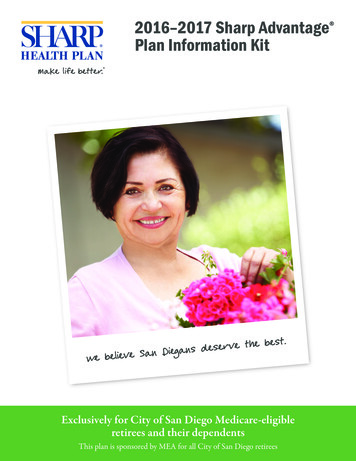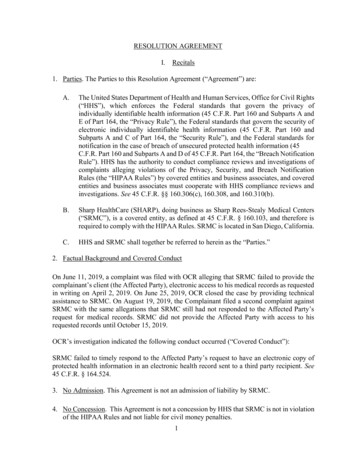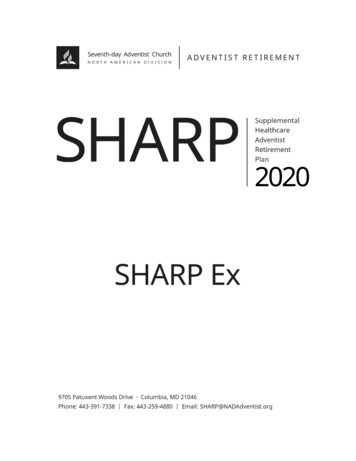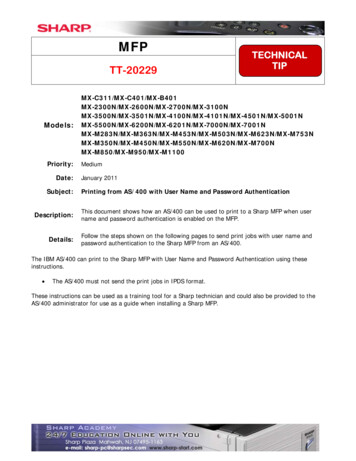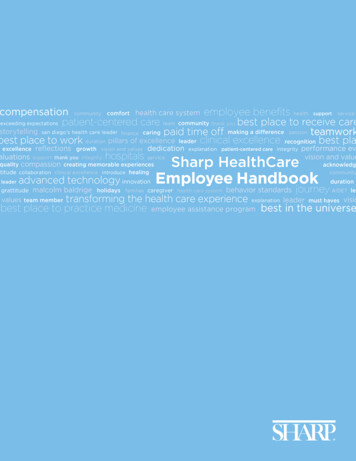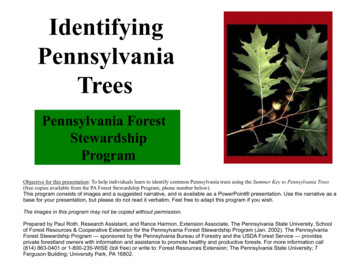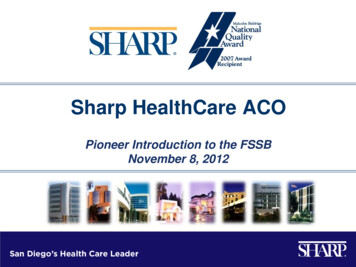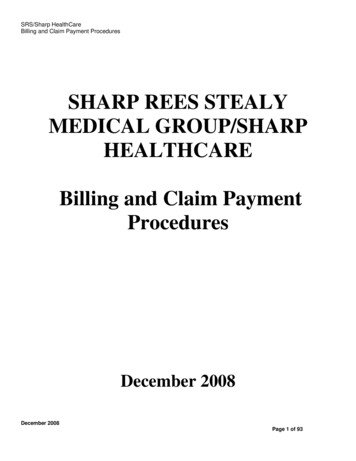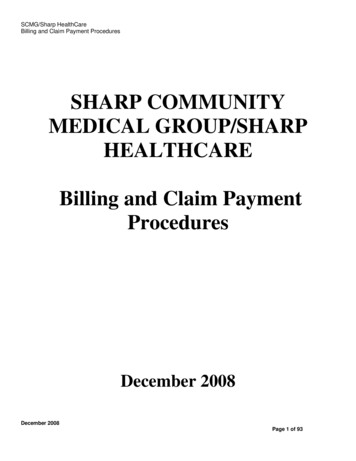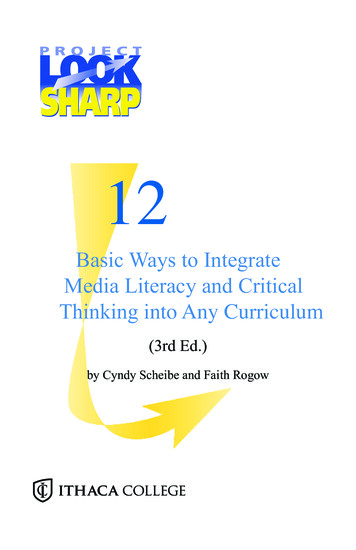
Transcription
12Basic Ways to IntegrateMedia Literacy and CriticalThinking into Any Curriculum(3rd Ed.)by Cyndy Scheibe and Faith Rogow
Project Look Sharp is a media literacy initiativeof the Division of Interdisciplinary & International Studies at Ithaca College, working incollaboration with local school districts, NewYork State BOCES, the National Association forMedia Literacy Education (formerly AMLA),and other national media literacy organizations.Project Look SharpIthaca College1119 Williams HallIthaca, NY 14850-7290Phone: (607) 274-3471Fax: (607) 274-1925E-mail: looksharp@ithaca.eduWebsite: www.ithaca.edu/looksharp Ithaca College, 1999, 2002, 2004, 2008All rights reserved.Permission is granted to copy these materials within fair use guidelines, provided credit isgiven to Project Look Sharp and Ithaca CollegeAbout the AuthorsCyndy Scheibe, Ph.D., is an associate professor of psychology at Ithaca College, whereshe has taught courses in developmental psychology and television research for morethan 20 years. As the founder and executive director of Project Look Sharp, she has beenworking with K-12 teachers and teacher education faculty on media literacy issues since1995. She is also director of the Center for Research on the Effects of Television, whichshe founded with John Condry at Cornell University in 1983. Her publications include“A Deeper Sense of Literacy: Integrating Media Literacy into K-12 Education”(AmericanBehavioral Scientist, 2004) and “Piaget and Power Rangers: What Developmental Psychology Can Tell Us about Media Effects” (in Mazzarella, S. (Ed.), 20 Questions aboutChildren and Media, 2007).Faith Rogow, Ph.D., started Insighters Educational Consulting in 1996 to help peoplelearn from media and one another. In 20 years as a media educator, she has trained thousands of teachers, students, child-care providers, and parents to understand and harnessthe power of media, and has authored extensive teacher and discussion guides, trainermanuals, web materials, and media literacy materials for a variety of children’s programsand independent films. She is an advisor to Project Look Sharp and was founding president of the National Association for Media Literacy Education (formerly the Alliance fora Media Literate America).Layout and Redesign by Casey Lewis Ithaca College, 1999, 2002, 2004, 2008 All rights reserved. Permission is granted tocopy these materials within fair use guidelines, provided credit is given to the authors,Project Look Sharp, and Ithaca College.
12 Basic Ways to Integrate Media Literacy andCritical Thinking into Any CurriculumINTRODUCTIONThis booklet is designed for teachers and support staff at all gradelevels who are interested in using media literacy in their classroomcurricula. The approaches are based on the concept of weavingmedia literacy training into the curriculum whenever and whereverpossible throughout the school year. Routine integration is muchmore effective than simply treating media literacy as a special,isolated topic and may better meet the needs of teachers who arealready at capacity with the demands of a full curriculum.The 12 Basic Ways are based on the National Association forMedia Literacy Education’s (NAMLE) Core Principles of MediaLiteracy Education (available at www.AMLAinfo.org) and we recommend using that document along with this booklet as you planlessons. In addition, you will find that Project Look Sharp definesmedia very broadly, to include books, newspapers, magazines,radio, television, movies, videos, billboards, recorded music, videogames, and everything available via the Internet.MEDIA LITERACY EDUCATIONIn the U.S., media literacy education began in the 1970s with anemphasis on protection (from the so-called “bad” media content);most media literacy materials and initiatives were aimed at parents.Since then, there has been a shift toward an emphasis on media literacy as empowerment (stressing critical thinking and productionskills); more materials are now aimed at schools and teachers. Theempowerment model emphasizes the political, social, and economic implications of media messages and stresses the importance ofusing media effectively and wisely.We see the purpose of media literacy education today as it iscurrently defined by NAMLE:“to help students develop the habits of inquiry andskills of expression they need to be critical thinkers,effective communicators and active citizens in today’s world.”
1Practice general observation, criticalthinking, analysis, perspective-taking,and communication skills byteaching students to routinely ask the kinds of questions thatwill help them think critically about information presented in media (including the information from their textbooks or the popularmedia they use at home); see the end of this booklet for samplequestions. making your own decision-making process transparent by explaining how you assess credibility of sources and why you choosethe media that you use in class. pointing out ways in which media messages might be interpreted differently by people from different backgrounds or groups. beginning discussions of media “texts” or documents (not onlyprint, but also image- or sound-based “texts”) by asking studentswhat they notice. allowing students to go beyond the curricular issue at hand toidentify and comment on incidental aspects of a media message(e.g., the characteristics of the people presenting the material, thetechniques used to attract attention, and the ways in which advertising and product messages intrude into other types of mediacontent). fostering communication skills and creativity by encouragingthe production of media messages about a topic. being flexible in assignments, allowing students to choose whichmedia formats are the most effective way for them to communicatethe required information or complete the required task.
2Stimulate interest in a newtopic by asking students to do a media search for information abouta topic. showing an exciting video clip, playing a popular song, or reading a short poem or story (fiction or nonfiction) about the topic. having students work in small groups to read, analyze, and discuss a controversial magazine, newspaper, or online article aboutthe topic. using a short video, magazine illustration, blog entry, or brief article to stimulate discussion, encouraging students to express whatthey already know or their opinion about a topic. showing students how to search for information about the topicon the Internet and compare results from different search engines.WHEN BEGINNING NEW UNITS:Develop an information plan in consultation withthe students, including the types of media andother information sources the class will beusing, and the strengths and weaknesses of each.
3Identify how students’ prior ideasabout a topic have been influenced bymedia messages by Giving examples from popular media (e.g., films, advertising,music) to illustrate what students might already know or believeabout a topic, and discussing the accuracy of that knowledge. Drawing links between the way a topic is typically treatedacademically and how it might appear in popular media (e.g.,“poetry” in song lyrics or advertising jingles; mathematical graphsor charts used in political polls or news reports). Clarifying the way that specific terminology related to the topicmight be used differently in an academic sense than it might be inthe popular culture (e.g., a chemist’s use of the term “organic” incontrast to a food label sporting the word).Encourage students to pay attention to print, audio andvisual elements in media sources, noting informationthat can be learned, and impressioons created from theimages and sounds.
4Use media as a standard pedagogicaltool by designing assignments that require students to use more thanone type of media source. providing information about the topic through a variety ofmedia sources (books, newspaper/magazine articles, instructionalvideos, websites), comparing the usefulness of different media,and address conflicting information that may come from differentsources. using diverse media, especially in cases where image-based media can convey information more richly and effectively than wouldbe possible with a standard classroom discussion, demonstration,or traditional print text (e.g., a demonstration of mathematicsconcepts involving motion or dimension, an example of how newsmedia presented an historical event or speech, an electronic “fieldtrip” to an otherwise inaccessible place). encouraging students to follow (and write about) current events.including tracking a single story across diverse media sources. making use of popular or unusual media examples to deepenstudents’ understanding of a topic (e.g., restaurant menus to explore stereotypes, use of adjectives, economic issues, or healthclaims). encouraging students to share information in class that they havegotten from various media sources (inside or outside of class),letting them know that at any time, you or a classmate might askthem to identify their sources and explain why they found thosesources to be credible. asking students to design their written work as if it was a chapter in their text book, using headings, sub-headings, illustrations,sidebars, charts, etc., and helping them think about which information is important enough to highlight and why.
5Identifying sources for erroneousbeliefs about a topic by analyzing media content that misrepresents a topic or presentsfalse or misleading information about a topic. showing students examples of misleading ways in which dataare presented in media (e.g, citing statistics selectively to excludecontradictory evidence, presenting graphs without appropriatelyidentified x or y axes, using percentages or implying comparison without identifying the whole that the example is measuredagainst, asking leading survey questions). pointing out language constructs (e.g., passive voice) or wordsthat are often used to mislead or misrepresent (e.g., “new and improved” or “all natural”). identifying inaccurate or stereotyped beliefs held by studentsabout a topic that may have come from either overt or implied media messages (e.g., toys in pink boxes are only for girls, smoking iscool because movie heroes smoke, or Muslims are dangerous). encouraging students to create their own false or misleadingmedia messages (e.g., PSAs, print advertisements, news reports, adspoofs) and then have them present the message and “debunk” itfor the other students in the class.Always encourage students to get information frommore than one source and to compare information gathered from different sources. (Are there discrepenciesacross sources? Which aources are most credible forspecific types of information?)
6Develop an awareness of issues ofcredibility and perspective by teaching students how to recognize the sources of a media message, (e.g., creator, speaker, funder, distributor, etc. ), their purposeor goal, and how that might influence production choices (e.g.,what is included or omitted, selection of images, music, or language). asking questions routinely and consistently of ALL media (including media conveying a perspective you support). helping students learn to distinguish between fiction and nonfiction. identifying ways to decide which sources are credible about thistopic within different types of media (e.g., popular magazines vs.academic journals, wikis vs. traditional encyclopedias). explaining the factors used to determine why students mightweigh different kinds of media differently (e.g., if the informationis based on research or other evidence versus personal opinion). having students produce media messages about a topic, takinginto account ways in which perspective is introduced through thewords and tone they use , the sources on which they rely, what theyselected to present or leave out, etc. [As a guide, see Project LookSharp’s “Key Questions for Production”]. exploring how media messages reflect the identity of the creator or presenter of the message and how the same message mightcome across differently if it was presented or created by someoneof a different background, age, race, gender, etc. encouraging students to ask who benefits from or is disadvantaged by a media message.
7Compare the ways different mediapresent information about a topic by contrasting ways in which information about a topic might bepresented in a documentary film, a TV news report, a newspaperarticle, blog, or an instructional video (what is emphasized, what isleft out, what techniques are used to present the information, etc.). comparing the amount of time/space devoted to a topic in different media from the same time period and discuss why the difference occurs. analyzing different conclusions that might be drawn by peopleexposed to information presented in one medium versus another. discussing the strengths and weaknesses of different media tocommunicate a particular message and to reach particulartarget audiences. having students produce reports about a topic using differentforms of media, or manipulating the same information and visualsto convey different messages (e.g., create a news story that makesthe same event seem either fun or boring).
8Analyze the effect that specific mediahave had on a particular issue or topicacross different cultures and/orhistorically by discussing the role that the media have played (if any) in the history of a topic or in the framing of current debates. helping students assess the accuracy of reporting on a currentevent or debate (e.g., U.S. coverage of global warming or a military conflict compared to coverage in other countries). discussing how people of earlier generations might have learnedabout a selected topic, what sources of information were availableto them compared with sources available to us now, and what difference that would make in people’s lives. exploring the level of knowledge about a topic in different cultures and how that knowledge is influenced by the media available. identifying media forms that are dominant or available in othercultures that may be seldom used in the United States, andvice versa. asking students to include information about available mediaand media ownership in reports about other countries or cultures.
9Build and practice specific curricularskills by using print media (books, newspapers, magazines, texting, webpages) to practice reading and comprehension skills, and to helpstudents identify various types of and purposes for writing. substituting excerpts from existing media for standard storyproblems or practice examples (e.g., to correct grammar or spelling, check calculations, or identify adjectives or adverbs). using media production to practice skills (e.g., speaking, grammar, research, writing, math (e.g., calculating timing or proportions of media messages). preparing examples for practice skills that include media literacy information (e.g., compare the lengths of news stories aboutdifferent topics, collect statistical data by surveying family orclassmates about their media use or preferences). fostering computer skills by encouraging students to search forinformation on the Internet, develop multimedia projects, and usecomputers to present information about a topic. using media (e.g., websites, cable access, radio) to provide students with a broader audience for their work. Apply high standardsfor student work that is presented via media, giving opportunitiesfor revision or rehearsal.
10Facilitate use of a range of mediaformats to express students’ opinionsand illustrate their understanding ofthe world by encouraging students to analyze media messages on issues ofparticular interest to them (e.g., messages about sex and gender orpopularity, messages promoting harmful behaviors, race and agedistortions in the “media world” compared with the real world,messages about how media effect them, and/or advertising targetedto people their age). encouraging students to express their feelings and knowledgeby designing and producing media (e.g., a video game, newspaper,Web page, etc.) about the topic for other students to view. encouraging thoughtful critiques of various media productions. promoting discussion of different points of view about popularmedia articles and productions. discussing with students who their intended audience is and whomight actually have access to the media they create.WHEN USING VIDEO TO TEACH:- Show short segments rather than entire films orprograms.- Leave the lights on to facilitate active viewing anddiscussion.- Before viewing, let the students know what theyshould be looking and listening for.- During viewing, pause periodically to point out orask questions about important information.
11Use media as a assessment tools by presenting a media “text” at theend of a unit(e.g., an ad, newspaper op ed, web site faq, film clip)that contains false informationabout the topic and see if studentscan identify what is correct andwhat is incorrect in the message. having students summarize theirknowledge about a topic in a finalreport that employs media formatsbeyond the standard written report(e.g., computer-illustrated reports,audio or video productions, photographic illustrations). encouraging students to workin groups to illustrate their understanding of a topic by creatingmock media productions (e.g.,newspapers, advertisements, newsreports, live or videotaped skits). assessing observation and memory skills by asking students tolook for specific things when theyview videos or read print material,and then asking them about thosethings afterward.INTEGRATEMEDIA LITERACYQUESTIONS INTO“K-W-L”:After asking, “Whatdo you know?”Ask, “Where did youget your informationor ideas? (What areyour sources?)”After asking, “Whatdo you want tolearn?”Ask, “Where are youlikely to find crediblesources that couldanswer your questions?”After asking, “Whatdid you learn?”Ask, “Which sourceswere the most helpful?”
12Connect students to thecommunity and work towardpositive change by finding collaborative possibilitiesfor projects with community institutions (e.g., museums, libraries, galleries) that involve students analyzing or creating media messages. having students contact community service agencies related toa curriculum area and offer theirproduction assistance for agencyprojects (e.g., photography, video,design and layout, or computerskills). encouraging older students toteach production techniques ormedia literacy principles to youngerstudents. using media forums (e.g., localcommunity access TV, newspapers,social networking sites or listservs)to solicit input or share researchabout a topic. helping students see the powerof media by encouraging them touse media to give people in theircommunity a voice (e.g., record andshare oral histories, interviews, localevents, etc.).AS YOU DEVELOPLESSONS, ASKYOURSELF IFYOU CANANSWER “YES”TO THEFOLLOWING: Am I giving studentsthe skills they need todetermine what theythink the message(s)might be rather thantrying to tell them whatI think the message is. Have I let studentsknow that I am opento accepting any wellsubstantiated interpretations (rather thanconveying the messagethat my interpretation isthe only correct view)? At the end of thislesson are studentslikely to be more analytical than cynical?
ABOUT PROJECT LOOK SHARPPROJECT LOOK SHARP is a media literacyinitiative of the Division of Interdisciplinary andInternational Studies at Ithaca College, workin incollaboration with local school districts, New Yorkstate BOCES, the Alliance for a Media LiterateAmerica, and other national media literacy organizations.The project is designed to promote and support the integration of medialiteracy and critical thinking into curricula at all grade levels and acrossinstructional areas, as well as to evaluate the effectiveness of medialiteracy education in the schools. This curriculum-driven initiative worksdirectly with teachers and support staff to reach students and aims tofoster a spirit of collaboration among educators using media literacy.Project Look Sharp provides curriculum materials, strategies, and advicefor media literacy instruction, and acts as a liaison between educators andthe media literacy field at large.The primary goals of Project Look Sharp are: To promote and support media literacy education at the community,state, and national levels To provide teachers with ongoing pre-service and in-service trainingand mentoring in media education To work with teachers to create new or revised teaching materialsand pedagogical strategies that incorporate media literacy and enhanceclassroom practice To develop and publish curriculum materials that infuse media literacyinto core content To evaluate the effectiveness of media literacy as a pedagogical approach to education To develop a model for including media literacy in the school curriculum at all grade levels and across all instructional areas, and to showhow media literacy can help teachers address new and existing learningstandards.
About Media LiteracyMedia Literacy is typically defined as the abilty to access, analyze, evaluate, and produce communication in a variety of forms. Itis similar to information literacy and involves many componentsof technology literacy as well.The term “media” generally refers to mass media messages communicated through visuals, language, and/or sound that are produced for a remote mass audience using some form of technology.These include traditional print-based media (e.g., books, newspapers, magazines, direct mail); audiovisual media (e.g., computergames, the Internet, blogs, wikis). Media also include recordedmusic, billboards and other signs, most games, package labels,and advertising in all of its forms. In the classroom, the media arelikely to include textbooks, posters, and maps.Like traditional literacy, media literacy involves critical thinking, analytical skills, and the ability to express oneself in differentways. Being media literate also entails using media wisely andeffectively, including being able to judge the credibility of information from different sources. In the same way that traditional literacy includes writing as well as reading skills, media literacy alsoemphasizes producing efective communication through a variety ofdifferent media forms.The process of effective media analysis is based on the followingconcepts:1. All media messages are “constructed.”2. Each medium has different characteristics, strengths, and aunique “language” of construction.3. Media messages contain embedded values and points of view.4.All media messages contain embedded values and points of view.5. People use their individual skills, beliefs and experiences toconstruct their own meanings from media messages.6. Media and media messages can influence beliefs, attitiudes, values, behaviors, and the democratic process.
Integrating Media Literacy Into The ClassroomIn order for students to develop the analytical and technical skillsneeded to be fully literate in a contemporary sense, media analysis and media production should be continuosly reinforced fromkindergarten though high school (and beyond) in many differentsubject areas. The purpose of media literacy education is to helpindividuals of all ages develop the habits of inquiry and skills ofexpression that they need to be critical thinkers, effective comminicators and active citizens in today’s world. Project Look Sharpendorses the Core Principles for Media Literacy Education in theUnited States, developed by the National Association for MediaLiteracy Education (formerly AMLA) in 2007, which state thatmedia literacy education: requires active inquiry and critical thinking about the messageswe receive and create expands the concepts of literacy (i.e., reading and writing) toinclude all forms of media builds and reinforces skills for learners of all ages, and like printliteracy, those skills necessitate integrated, interactive and repeatedpractice develops informed, reflective and engaged participants essentialfor a democratic society recognizes that media are a part of culture and function asagents of socialization affirms that people use their individual skills, beliefs and experiences to construct their own meanings from media messages.Media literacy can be readily integrated into existing curricula on awide range of topics and can be a valuale tool for exploring approaches to education that are interdisciplinary and that recognizedifferent learning styles. Media literacy is particularly powerfulin encouraging participatory citizenship and the appreciation ofmultiple perspectives.
Key Questions to AskWhen Analyzing Media MessagesWhen engaging in critical analysis of any media message, it’s useful to ask some, or all, of the following key questions for mediaanalysis:About Authorship, Purpose and Economics Who made this? Who was this made, and who paid for it? Who was this made for (and how do you know)?About Techniques and Content What messages are conveyed? What techniques are usedto communicate each message, and why? What ideas, values, information, and/or points of vieware overt? Implied? What is left out of this message that might be importantto know?About the Context and Credibility When was this made? Where or how was it shared withthe public? Is this fact, opinion, or something else? How credible is this? What are the sources of information, ideas, or assertions?About the Audience and Impact How might different people interpret this differently? Who might benefit from this? Who might be harmedby it? What is my interpretation of this, and what do I learnabout myself from my reaction or interpretation? What kinds of actions might I take in response to this?These questions are particularly useful when introducing the concept of media literacy to a group or class of students, or when firstusing a new media resource in the classroom.
For free downloadable copies of the 12 Waysbooklet,go to:www.ithaca.edu/looksharpProfessional Development ServicesProject Look Sharp offers a variety of services for individual teachersand school districts, teacher education students and faculty, andother professionals working with K-12 school systems. These servicesinclude the following:Summer Media Literacy InstituteEach year Project Look Sharp conducts an intensive media literacyinstitute for teachers, support staff, college faculty, and other professionals working with students in an educational setting. Participants receivetraining in the theory and practice of media literacy, learn applicationsfor digital technology, and work individually with a Look Sharp “coach”to develop a media literacy integration project during the following year.Workshops and SpeakersProject Look Sharp personnel are available for large or small grouppresentations and workshops on a variety of media literacy topics. Theserabge from a general introductory presentation on the use of medialiteracy in the classroom to topical workshops (e.g., Youth Culture andNew Technologies), and trainings for current Project Look Sharp kits.Website and PublicationsProject Look Sharp publishes curriculum kits and other media literacymaterials for national and international dsitribution, each using medialiteracy as a pedagogical appraoch for teaching core content in socialstudies, science, and other curriculum areas. Most kits and materials,including the booklet 12 Basic Ways to Integrate Media Literacy andCritical Thinking into Any Curriculum, 3rd edition (Scheibe & Rogow,2008) are available, free, on the website. The inquire about purchasingprint copies of current curriculum kits or lessons along with the DVD’sor CD’s of kit media materials, or to watch for upcoming kits and lessons, visit our website at: www.projectlooksharp.org.
national Studies at Ithaca College, working in collaboration with local school districts, New York State BOCES, the National Association for Media Literacy Education (formerly AMLA), and other national media literacy organizations. Project Look Sharp Ithaca College 1119 Williams Hall Ithaca, NY 14850-7290 Phone: (607) 274-3471 Fax: (607) 274-1925
